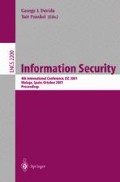Abstract
A security threat that affects the Java environment (as a typical environment where code is made available to the user machine) is the reverse-engineering and code-understanding of the architecture-neutral bytecode format. A natural protection strategy is to hide parts of the execution in trusted locations (e.g., servers). However, the implementation and automatization of such an approach (beyond the abstract idea) is a challenging problem. In this paper, we present a novel software protection strategy and its automatization (implemented architecture) which materialize the above idea. It is employed in protecting the binary source of Java class files. Our software protection strategy partitions “programmer selected” classes of an application into server classes and client classes. Server classes contain the actual class code and run only on trusted systems (which we call servers but they can be other dedicated machines). Client classes, on the other hand, are assumed to perform most of the task (but the sensitive part) and execute on user systems; they must interact with their corresponding server class in order to execute the sensitive code and provide the behavior of the original class. We propose and implement DISSECT (DIStribution for SECurity Tool), an architecture based on the above partitioning (dissection) strategy, for Java 1.1. The tool relieves the developers from actually writing distributed applications by distributing the application automatically, according to designated sensitivities of application portions. We note that the remote execution of classes may increase the overhead. Thus, we have conducted initial experiments to understand the impact of partitioned classes on performance.We report initial performance results which show the overhead and demonstrate when it is low or non-existing, when it is high, and when we actually gain performance by partitioning.
This work was supported by the National Science Foundation under Grant No. 9256688 and the NY State Center for Advanced Technology in Telecommunications. The author is now with IBM T. J.Watson Research Center, Hawthorne, NY.
Access this chapter
Tax calculation will be finalised at checkout
Purchases are for personal use only
Preview
Unable to display preview. Download preview PDF.
References
Ahpah Software, Inc. SourceAgain. http://www.ahpah.com .
Dirk Balfanz. Access Control for Ad-Hoc Collaboration. Ph.D. Dissertation, pages 75–110, Princeton University, USA, Jan. 2001. http://ncstrl.cs.princeton.edu/expand.php?id=TR-634-01 .
B. Barak, O. Goldreich, R. Impagliazzo, S. Rudich, A. Sahai, S. Vadhan, and K. Le. On the (Im)possibility of Obfuscating Programs. Crypto’01.
Petr Beckmann. A History of Pi. St. Martin’s Press, pages 144–145, 1971.
A. D. Birrell and B. J. Nelson. Implementing Remote Procedure Calls. In ACM TOCS, 2(1):39–59, Feb. 1984.
C. Collberg, C. Thomborson, and D. Low. A Taxonomy of Obfuscating Transformations. Technical Report 148, University of Auckland, NZ, July 1997. http://www.cs.auckland.ac.nz/~collberg/Research/Publications/CollbergThomborson97a/index.html .
C. Collberg, C. Thomborson, and D. Low. Manufacturing Cheap, Resilient, and Stealthy Opaque Constructs. In Proc. of POPL 1998, pages 184–196, Jan. 1998.
DashO Obfuscation Edition. http://www.preemptive.com/products.html .
N. Eastridge. Java Shrinker & Obfuscator v1.04. http://www.e-t.com/jshrink.html , March 1999.
L. Gong. Inside Java 2Platform Security: Architecture, API Design, and Implementaion. Addison-Wesley, 1999.
S. Hada. Zero-Knowledge and Code Obfuscation. Asiacrypt 2000, LNCS 1976, Springer, 2000.
C. S. Horstmann and G. Cornell. Core Java 1.1, Volume II-Advanced Features. Sun Microsystems Press, 1998.
IBM. Cryptographic cards home page. http://www.ibm.com/security/cryptocards .
Jasmin. http://www.cat.nyu.edu/meyer/jasmin/ .
JAva Decompiler, Jad. http://www.geocities.com/SiliconValley/Bridge/8617/jad.html .
KB Sriram. HashJava. http://www.sbtech.org/ , Sept 1997.
D. Malkhi, M. Reiter, and A. Rubin. Secure Execution of Java Applets using a Remote Playground. In Proc. of the 1998 IEEE Sym. on Security and Privacy.
J. Meyer and T. Downing. Java Virtual Machine. O’Reilly & Associates, 1997.
M. Pistoia, D. F. Reller, D. Gupta, M. Nagnur, and A. K. Ramani. Java 2 Network Security, 2nd edition. Prentice Hall, 1999.
T. Sander and C. Tschudin. Towards Mobile Cryptography. In Proc. of the 1998 IEEE Sym. on Security and Privacy, pages 215–224, 1998.
T. Sander, A. Young, and M. Yung. Non-Interactive Crypto Computing for NC 1. In Proc. of the 40th FOCS, pages 554–566, IEEE 1999.
SPEC JVM Client98 Suite, Standard Performance Evaluation Corporation, Release 1.0 8/98. http://www.spec.org/osg/jvm98 .
Sun Microsystems, Inc. ClassServer. ftp://java.sun.com/pub/jdk1.1/rmi/class-server.zip, 1997
Sun Microsystems, Inc. Java Object Serialization Specification, Rev 1.2, Dec. 1996.
Sun Microsystems, Inc. Java Remote Method Invocation, 1997.
Sun Microsystems, Inc. Jini architectural overview, http://www.sun.com/jini/whitepapers/architecture.html .
J. D. Tygar and B. Yee. Dyad: A System for Using Physically Secure Coprocessors. In Proc. of Technical Strategies for Protecting Intellectual Property in Networked Multimedia Environment. Annapolis, MD, 1994.
E. Valdez and M. Yung. Software DisEngineering: Program Hiding Architecture and Experiments. Information Hiding ’99, LNCS 1768, Springer, 2000.
Hanpeter van Vliet. Mocha, the Java Decompiler. http://www.brouhaha.com/~eric/computers/mocha.html , Aug 1996.
U. G. Wilhelm. Cryptographically Protected Objects. http://lsewww.epfl.ch/~wilhelm/CryPO.html , May 1997.
U. G. Wilhelm, S. Staamann and L. Buttyan. Introducing Trusted Third Parties to the Mobile Agent Paradigm. Secure Internet Programming: Security Issues for Mobile and Distributed Objects, LNCS 1603, Springer, 1999.
Matt T. Yourst. Inside Java Class Files. http://www.laserstars.com/articles/ddj/insidejcf/ .
WingSoft Corporation. WingDis Java Decompiler. http://www.wingsoft.com/ .
Author information
Authors and Affiliations
Editor information
Editors and Affiliations
Rights and permissions
Copyright information
© 2001 Springer-Verlag Berlin Heidelberg
About this paper
Cite this paper
Valdez, E., Yung, M. (2001). DISSECT: DIStribution for SECurity Tool. In: Davida, G.I., Frankel, Y. (eds) Information Security. ISC 2001. Lecture Notes in Computer Science, vol 2200. Springer, Berlin, Heidelberg. https://doi.org/10.1007/3-540-45439-X_9
Download citation
DOI: https://doi.org/10.1007/3-540-45439-X_9
Published:
Publisher Name: Springer, Berlin, Heidelberg
Print ISBN: 978-3-540-42662-2
Online ISBN: 978-3-540-45439-7
eBook Packages: Springer Book Archive

